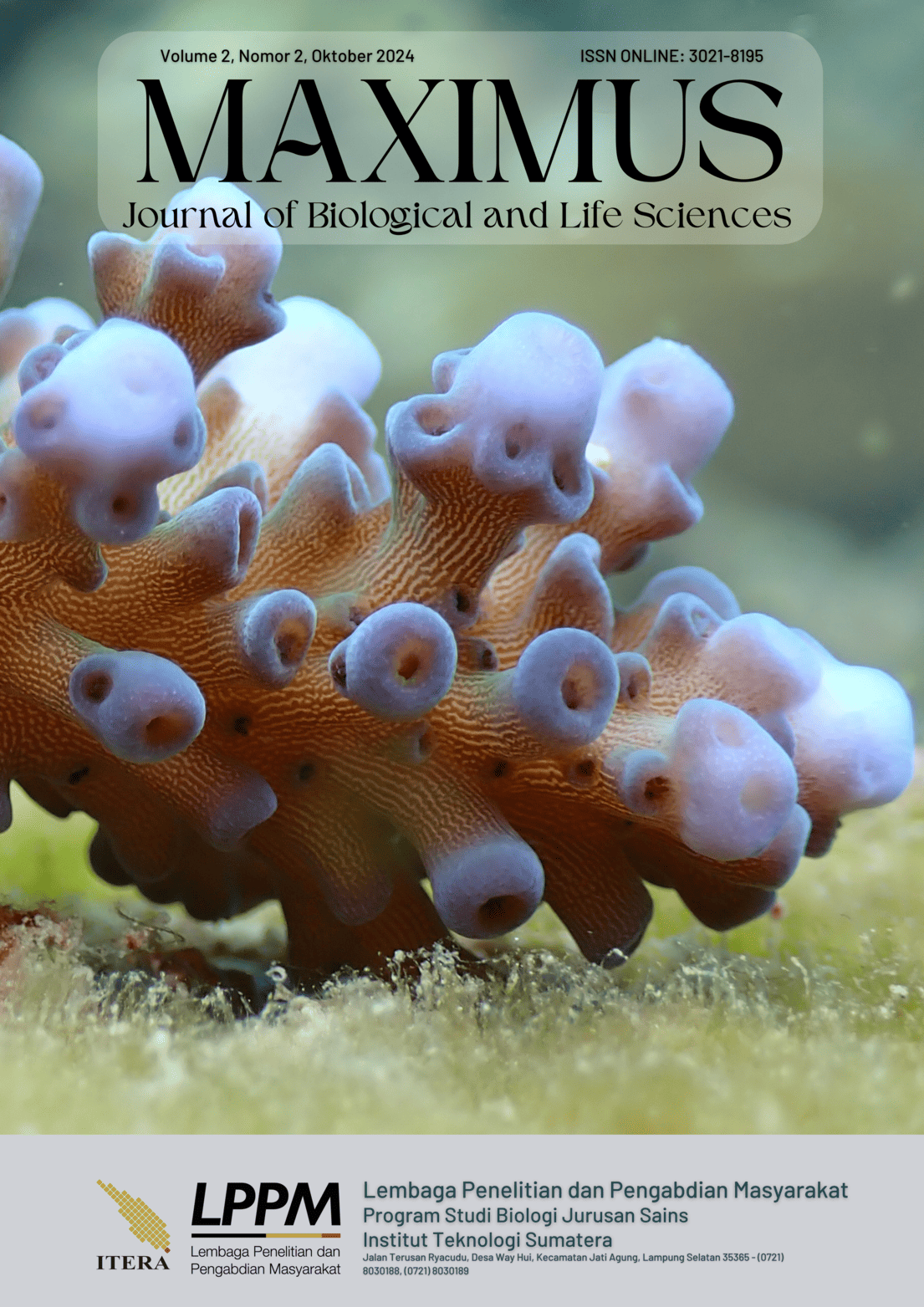Penyerapan Pakan Berbahan Dasar Kacang Hijau (Vigna radiata) pada Mencit Betina (Mus musculus)
Abstract
Mencit (Mus musculus) adalah hewan model utama dalam penelitian biomedis. Kebutuhan akan pakan untuk pertumbuhan mencit mendorong pengembangan pakan alternatif dengan formulasi sesuai kebutuhan nutrisi. Salah satu bahan yang dapat digunakan adalah kacang hijau (Vigna radiata). Penelitian ini menerapkan pakan alternatif dari kacang hijau (Vigna radiata) untuk menunjang pertumbuhan mencit sebagai hewan model laboratorium dan mengamati penyerapan pakan yang diberikan. Penelitian ini bertujuan untuk membandingkan penyerapan pakan berbahan dasar kacang hijau pada berbagai variasi konsentrasi terhadap dengan pakan komersial. Perlakuan pada penelitian ini adalah kelompok kontrol (100% pakan komersial), KH85 (85% kacang hijau), KH75 (75% kacang hijau), KH65 (65% kacang hijau), dan KH55 (55% kacang hijau). Perlakuan dan pengambilan data dilakukan setiap hari selama dua bulan. Setiap mencit ditimbang sebelum dan sesudah makan untuk menentukan berapa banyak pakan yang mereka konsumsi. Mencit juga ditimbang setelah defekasi untuk menentukan berapa banyak pakan yang diserap pencernaan mencit. Berdasarkan hasil penelitian, perlakuan KH65 memiliki nilai penyerapan pakan yang tertinggi dibandingkan perlakuan lain, meskipun tidak terdapat perbedaan nyata dari pakan yang dimakan dan diserap dari seluruh perlakuan. Mencit dapat menyerap formulasi pakan berbahan dasar kacang hijau sebaik pakan komersial. Efisiensi pakan dapat dipengaruhi oleh digestibilitas bahan pakan, kebutuhan energi untuk menjaga berat badan, juga efisiensi pertumbuhan jaringan tubuh. Pada mencit betina, penyerapan pakan berbahan dasar kacang hijau setara dengan pakan komersial BR II sehingga pakan alternatif kacang hijau berpotensi menjadi pakan alternatif.
Downloads
References
Björck, I., Granfeldt, Y., Liljeberg, H., Tovar, J., & Asp, N. (1994). Food properties affecting the digestion and absorption of carbohydrates. The American Journal of Clinical Nutrition, 59(3), 699S-705S. https://doi.org/10.1093/ajcn/59.3.699S
Bryda, E. C. (2013). The Mighty Mouse: The impact of rodents on advances in biomedical research. Missouri Medicine, 110(3), 207–211.
Cook, G. C. (1974). Some factors influencing absorption rates of the digestion products of protein and carbohydrate from the proximal jejunum of man and their possible nutritional implications. Gut, 15(3), 239–245.
Dahiya, P. K., Linnemann, A. R., Van Boekel, M. A. J. S., Khetarpaul, N., Grewal, R. B., & Nout, M. J. R. (2015). Mung Bean: Technological and Nutritional Potential. Critical Reviews in Food Science and Nutrition, 55(5), 670–688. https://doi.org/10.1080/10408398.2012.671202
Harkness, J. E., Harkness, J. E., & American College of Laboratory Animal Medicine (Eds.). (2010). Harkness and Wagner’s biology and medicine of rabbits and rodents (5th ed). Wiley-Blackwell ; American College of Laboratory Animal Medicine.
Horikawa, K., Hashimoto, C., Kikuchi, Y., Makita, M., & Oishi, K. (2022). Wheat alkylresorcinol increases fecal lipid excretion and suppresses feed efficiency in mice depending on time of supplementation. Nutrition, 103–104, 111796. https://doi.org/10.1016/j.nut.2022.111796
Jaric, I., Voelkl, B., Amrein, I., Wolfer, D. P., Novak, J., Detotto, C., Weber-Stadlbauer, U., Meyer, U., Manuella, F., Mansuy, I. M., & Würbel, H. (2024). Using mice from different breeding sites fails to improve replicability of results from single-laboratory studies. Lab Animal, 53(1), 18–22. https://doi.org/10.1038/s41684-023-01307-w
Knapka, J. J. (1999). Nutrition of Rodents. Veterinary Clinics of North America: Exotic Animal Practice, 2(1), 153–168. https://doi.org/10.1016/S1094-9194(17)30145-7
Kumar, S., Rajput, M. K., & Yadav, P. K. (2021). Laboratory Animal Nutrition. In P. Nagarajan, R. Gudde, & R. Srinivasan (Eds.), Essentials of Laboratory Animal Science: Principles and Practices (pp. 373–404). Springer. https://doi.org/10.1007/978-981-16-0987-9_16
Kumari, P., Meena, M., Gupta, P., Dubey, M. K., Nath, G., & Upadhyay, R. S. (2018). Plant growth promoting rhizobacteria and their biopriming for growth promotion in mung bean (Vigna radiata (L.) R. Wilczek). Biocatalysis and Agricultural Biotechnology, 16, 163–171. https://doi.org/10.1016/j.bcab.2018.07.030
Mutiarahmi, C. N., Hartady, T., & Lesmana, R. (2021). USE OF MICE AS EXPERIMENTAL ANIMALS IN LABORATORIES THAT REFER TO THE PRINCIPLES OF ANIMAL WELFARE: A LITERATURE REVIEW. Indonesia Medicus Veterinus, 10(1), 134–145. https://doi.org/10.19087/imv.2020.10.1.134
National Research Council. (2011). Guide for the Care and Use of Laboratory Animals: Eighth Edition (p. 12910). National Academies Press. https://doi.org/10.17226/12910
Neha, Chandra, R., Pareek, N., & Raverkar, K. P. (2021). Enhancing Mungbean (Vigna radiata L.) Productivity, Soil Health and Profitability through Conjoint use of Rhizobium and PGPR. LEGUME RESEARCH - AN INTERNATIONAL JOURNAL, Of. https://doi.org/10.18805/LR-4552
Pan, X., & Hussain, M. M. (2009). Clock is important for food and circadian regulation of macronutrient absorption in mice. Journal of Lipid Research, 50(9), 1800–1813. https://doi.org/10.1194/jlr.M900085-JLR200
Pellizzon, M. A., & Ricci, M. R. (2020). Choice of Laboratory Rodent Diet May Confound Data Interpretation and Reproducibility. Current Developments in Nutrition, 4(4), nzaa031. https://doi.org/10.1093/cdn/nzaa031
Peters, L. L., Robledo, R. F., Bult, C. J., Churchill, G. A., Paigen, B. J., & Svenson, K. L. (2007). The mouse as a model for human biology: A resource guide for complex trait analysis. Nature Reviews Genetics, 8(1), 58–69. https://doi.org/10.1038/nrg2025
Ricci, M. (2015). Laboratory animal control diets: Very important, often neglected. Lab Animal, 44(6), 240–241. https://doi.org/10.1038/laban.786
Sutherland, T. M., Biondini, P. E., & Ward, G. M. (1974). Selection for Growth Rate, Feed Efficiency and Body Composition in Mice. Genetics, 78(1), 525–540. https://doi.org/10.1093/genetics/78.1.525
Toth, L. A., & Gardiner, T. W. (2000). Food and water restriction protocols: Physiological and behavioral considerations. Contemporary Topics in Laboratory Animal Science, 39(6), 9–17.
Whary, M. T., Baumgarth, N., Fox, J. G., & Barthold, S. W. (2015). Chapter 3—Biology and Diseases of Mice. In J. G. Fox, L. C. Anderson, G. M. Otto, K. R. Pritchett-Corning, & M. T. Whary (Eds.), Laboratory Animal Medicine (Third Edition) (pp. 43–149). Academic Press. https://doi.org/10.1016/B978-0-12-409527-4.00003-1
Copyright (c) 2024 Lisana Husna Imaniar, Dina Anggraini, Khaerunissa Anbar Istiadi

This work is licensed under a Creative Commons Attribution-NonCommercial 4.0 International License.
All rights, title and interest in the copyright to manuscript submitted, if accepted, are hereby transferred to Maximus : Journal of Biology and Life Sciences. This includes display of the accepted article in electronic form on the internet before and/or after print publication (if any). The authors must confirm that the manuscript contains no material that would violate the copyright or any other right of any other person. The authors reserve unto themselves the following rights the right to make copies for personal teaching use, and to reproduce reasonable quantities for personal use only; the right to reuse figures and tables in articles published in other books or journals (with bibliographic reference to Maximus : Journal of Biology and Life Sciences); any proprietary rights other than copyright, including the right to any patentable subject matter contained in the manuscript and the right to deny any subsequent commercial use.







